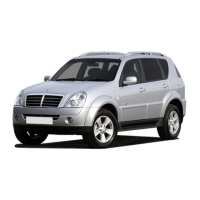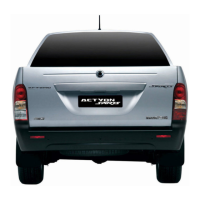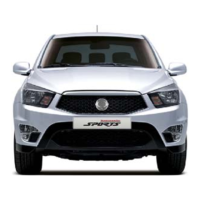5–4 TURBO CHARGER SYSTEM
CAUTION
• At low ambient temperature, or
when ever the vehicle has not been
used for a long period, normal
engine oil pressure and flow is af-
fected. Under these conditions the
engine should be started and al-
lowed to idle for a few minutes
before operating at a higher rpm.
• Avoid long periods of engine
idling. The combination of low-
pressures in the turbine and com-
pressor may allow oil to seep past
the seal into the turbine or the
compressor.
TURBOCHARGER INSPECTION
Good maintenance practices should be ob-
served, particularly regarding air filtration
and oil quality and filtration.
These areas are important because of a
turbocharger’s speed of operation.
Proper operating procedures and preventive
maintenance practices enhance good turbo-
service lift and performance.
1. Turbo charger 2. Oil inlet line
3. Intercooler inlet line 4. Intake line
CAUTION
Operating the turbocharger system
without the intake and exhaust mani-
fold mounting can result in severe
engine damage.
PREVENTIVE MAINTENANCE
The vehicle owner should be encouraged to
observe the following precautions to ensure
maximum turbocharger service life.
CAUTION
• Operate the engine above idle only
after normal engine oil pressure
has been established. Revolving
up the engine, immediately after
start-up, could result in damage to
the turbocharger unit.
Forcing the turbocharger to oper-
ate before the bearings are ad-
equately lubricated creates unnec-
essary friction.
• Take steps to reduce temperature
and speeds from their maximum
before shutting down the engine.
• The turbocharger may need to be
pre-oiled after and oil change or
any service that involves oil drain-
ing. Crank the engine a few times
before allowing start, then start
the engine and allow it to idle for
a period to establish full oil cir-
culation and pressure before op-
erating at higher rpm.
K140_RHD_EN_05.p65 2004-11-11, ¿ÀÈÄ 4:084

